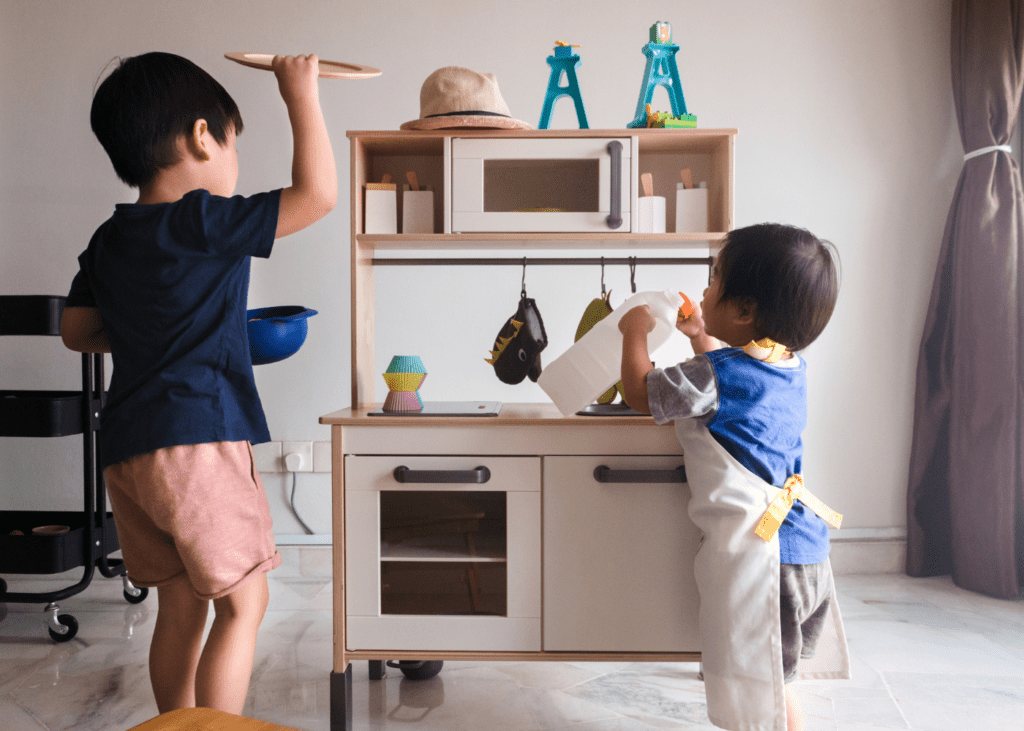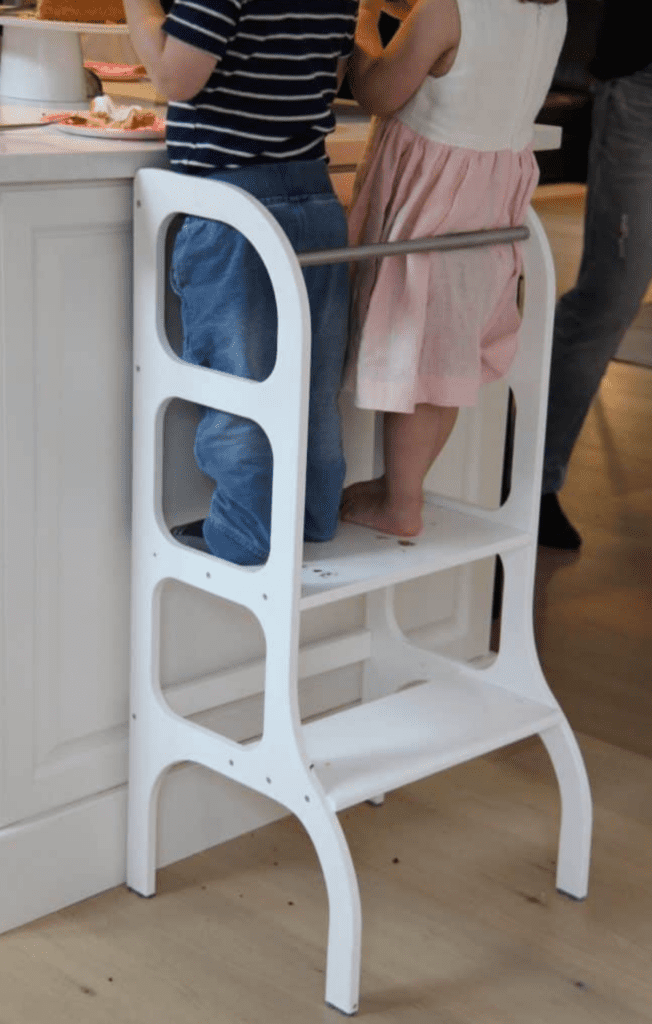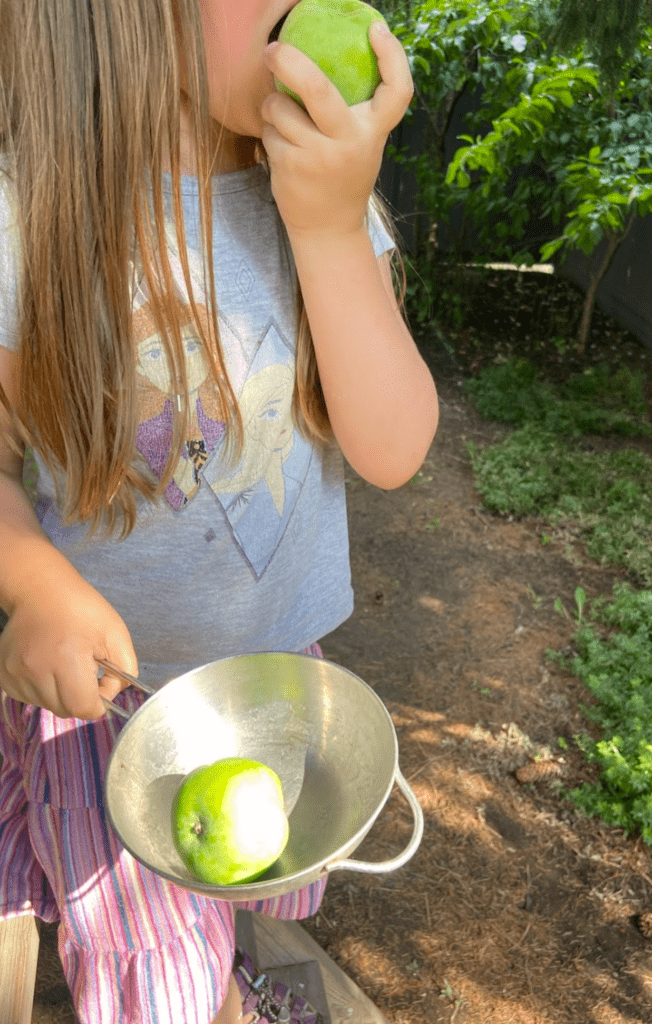The kitchen is where we spend most (or at least lots) of our time. When you have growing (and seemingly always-hungry little ones in your house), this is even more true! Since your children also spend tons of time here, why not make the space inviting for them, too?
Something to keep in mind here is that when designing a Montessori-friendly home, including a play space or bedroom, the goal is that the area is intentional and empowering for them. When it comes to shared spaces, on the other hand, decor and functionality should be beneficial to everyone using the space.
Read on for ideas about creating a Montessori kitchen space for your child!
What is a Montessori kitchen?
Basically, it’s a child-friendly kitchen space where your little one can practice practical life activities like meal preparation and washing hands.
Whether you decide to go with a Montessori play kitchen, a functional kitchen, or just have kitchen tools that your kiddos can use and access, we’ve got plenty of Montessori kitchen ideas for you in this post.

Montessori “play kitchen” or “functional toddler kitchen”
Montessori Play Kitchens are mini toy kitchens generally made out of wood that can be placed within sight of the main family kitchen. These structures are great for younger kids who are just starting to get involved in day-to-day kitchen cooking and cleaning activities.
Here are a few of the best places to find high-quality Montessori play kitchens:
A play kitchen may be a functional kitchen with running water for washing dishes or hands, or it may be entirely meant for pretend play. Either way, having a toy kitchen that closely resembles a real-life model will help your children hone many practical life skills. They can learn to wash hands, prepping food, and both cleaning and putting dishes away.
Whether you choose a Montessori kitchen that more closely resembles a functional toddler kitchen or is strictly meant to be a play kitchen, you may also want to look for one that has a water dispenser of some kind. This could be as simple as a plastic sink and a water jug or one that has pouring water!
Another thing to include is child-sized furniture. A nice addition to a Montessori play kitchen is a small table and small chairs. This idea gives your little one space for pretend play or a spot to eat their snacks at!

Kitchen Tower or Learning Tower
Also called “Kitchen Helpers” or “Learning Towers,” these Montessori-style stools are a great addition to any toddler-friendly home!
Basically, a learning tower is meant to bring your children up to counter height. This way, toddlers can work on skills that need to be done in a safe environment, like meal prep.
As far as children’s furniture goes, this is at the top of my list of favorites. Kitchen towers are excellent for a bunch of reasons. This piece of furniture lets your children more deeply explore and engage with the world around them by letting them safely stand taller.
With this piece, your young one can participate in so many more kitchen-based activities than they can while in your arms or sitting on a chair. This means increasing independence for your child while also being able to spend quality time together –win-win right?!
For example… Maybe they want to help you wash the dishes, rinse fruits in the sink or help cook and bake? With these towers, they can!
Not do these towers increase your child’s ability to participate in the kitchen, but they’re super safe as well. Though there are many unique designs, essentially these towers are built of a few steps, have three completely covered sides, and many have a bar at the back. This keeps your child safe from falling (unlike tippy stools and chairs).
Convinced that these learning towers would be a great addition to your home? You can find tons online if you’re looking to buy one, like this adorable Kitchen Helper Tower by Duck Woodworks Shop on Etsy. For those avid DIYers out there, there are also tons of great plans dependent on your woodworking level like this simple one from Etsy seller StellasCosmos.

On a side note… One thing that I have noticed with these is that since children can climb onto counters from these Montessori Kitchen Towers, they often will. This is all a part of testing boundaries and exploring their curiosity… And is completely normal!
With some gentle reminders to keep their feet on the stool, this phase will likely be passed through quickly. Another way to prevent this is always providing something for them to do, rather than them using the tower to just watch you! Even if you just give them a recipe card to look at or some veggies to investigate, keeping their hands busy is a great way to keep them from getting into things they shouldn’t on the counters.
Child-safe utensils
A big concern in the kitchen (and rightly so!) is safety. Between appliances, breakable glass and dishes, cleaning supplies, and sharp utensils, the kitchen can be difficult to configure in a safe way for your little one.
While many risks can be mitigated by child-proofing the space and keeping valuables/appliances out of reach, our goal here is to make the room feel inclusive.
In alignment with Montessori principles, we also want to design a space that is intriguing and empowering. Doing so will engage your child’s natural curiosity while letting them accomplish tasks by themselves!
If possible, I highly encourage parents to have a drawer or cupboard that their child knows they can access and use items from. Giving them their own space and tools makes them feel equally important and capable, after all!
Montessori kitchen ideas
Here are some things to think about including in a toddler kitchen:
- Mini whisks, spoons, and spatulas
- Mini rolling pins
- Child-sized oven mitts
- Small cutting boards
- Child-safe knives
- Measuring cups and spoons
- Cutting board
- Their own dishes
- The Montessori approach favors ‘real’ dishes. Consider getting your children a water glass, silverware, and dishware of their own
- Cloth napkins are also a fun touch! They’re more environmentally responsible than disposables, too

Inspiring mini-chefs: Practical life skills and cooking
Once you’ve got the tools required for your child to safely participate in kitchen activities, it all comes down to how to engage them. Montessori kitchens provide tons of practical learning opportunities – Children get to refine life skills like measuring, cleaning, and putting things away after using them all while creating delicious foods and treats.
Reasons for including your children in the kitchen
Before diving into how you can inspire your budding chefs, though, let’s talk about the benefits of your child helping out with cooking and baking tasks…
Bonding opportunities
As I mentioned at the beginning, we spend a lot of our time in the kitchen. So, when you can, why not take the chance to make some long-lasting memories with your little one while teaching them new things, too? As the daughter of an avid baker and cook, I can personally attest to the benefit that this has. Some of my best memories were made while helping my own Momma with kitchen tasks as a young child!
Sensory development
Cooking engages all of our senses through hands-on engagement with ingredients and tools. Offer lots of opportunities to learn by talking to your child about the way ingredients are changed as they are cut, blended, cooked, or melted!
Even clean-up time can engage the senses! Simply filling the sink with water and soap is a great opportunity to expose your child to a sensory experience while letting them help out, too.
Math/science skills
While some of us prefer to cook without measuring a thing (guilty!), you can easily teach your child math by measuring out ingredients! By counting the number of teaspoons or cups out, you’re also teaching them basic addition. Way more fun than worksheets, right?!
Math can even be taught while shopping – Try asking your child how many buns they will need for everyone in the family to have a hamburger, for example!
Heating, cooling, and liquefying ingredients are a few examples of how science in cooking. While doing these things, try talking to your children about the changes your ingredients are going through before turning them into the final dish.
Improved reading
Even if you’re using Grandma’s Cookie Recipe that is imprinted into your own brain, try your best to provide your child with recipe cards! Letting them read the numbers and instructions with you (or to you!) will deeper engage them in the task and enhance their reading skills.
Another way to get them excited is to buy or create their own cookbooks or recipe boxes. Little ones have a tough time visualizing what a recipe may look like – But when they see pictures of deliciois snacks/meals, it will get them excited about cooking!
Language development
Try talking through what you’re doing as much as you can with your child so that they deepen their kitchen vocabulary. Whether they’re kneading dough or whisking eggs, talking about what they’re doing will help them learn essential kitchen words and actions.
Enhanced fine motor skills
Manipulating utensils and preparing food is an amazing way to increase your child’s strength and coordination. By letting them spread, chop, stir, and peel ingredients, they get to develop these skills in a fun way!
Essential life skill development
Our kids won’t always be kids! Though of course, we are not all esteemed chefs or bakers, cooking and baking are essential life skills that we all need to learn as adults. So, why not start young!
When thinking about how to inspire your children, there are tons of opportunities. After implementing some of these simple Montessori principles in your kitchen, though, I am pretty confident that you won’t have much trouble doing so.
Montessori education and the kitchen
Remember, the Montessori method is focused on child-driven learning. This means that if we as adults set up a space for our little ones that are attractive, inclusive, and exciting, then in theory, the child will be naturally curious and want to engage with it.
By including them in kitchen activities, they are likely going to be naturally excited to cook with you! You can increase this by asking for their input – for example, simple questions like “What should we cook together tonight?” or “It’s pizza night! Which toppings should we put on the pizza?” make them feel included right from the get-go.

Increasing interest in food
Growing some ingredients at home is another great way to excite children about cooking. They will be so proud of the meal they make knowing that they helped to grow ingredients in your own garden!
No space for gardens? No problem… Try watching cooking shows together to increase their interest!
There are lots of fun ways to increase interest in food. One thing I like to do is have “rainbow meals” where we see if we can get every color of the rainbow into a meal. This results in a nutritionally dense plate and it’s a pretty creative process!
Conclusion
Including your little ones in kitchen activities is a fun way to work on practical life skills. By integrating concepts from the Montessori method, like promoting independence, responsibility, and pursuing a personal interest, your toddler’s experience in the kitchen can become more inclusive and exciting.
With some simple additions to your house, like a play kitchen, learning tower, and their own dishes and utensils, your little ones will be able to participate in all of the real-life tasks of a kitchen. They can prepare food with you, practice washing hands and dishes, and work on essential skills like self-feeding.

Leave a Reply